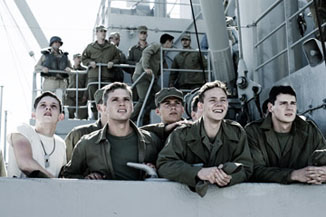|
|
Flags of Our Fathers: DVD ReviewBy D. James Ruccio IIIFebruary 6, 2007
The movie also attempts to explore the purpose of propaganda in warfare and the use of information as a tool. "We need easy to understand truths and damn few words" a character says. The idea that the picture was staged, a quiet rumor of the time (owing most likely to the fact that the picture captured the second, larger flag being raised) is a subtle question relevant perhaps given today's current conflict. But again it fights for importance throughout the script. All of these competing ideas are made that much harder to comprehend with the story, which is told in a series of flashbacks spanning three timelines. This leads to much confusion throughout and again hampers the movie's execution. It is not even clear until the last third of the movie that this story is being told to the son of one of the flag raisers. The audience is often left wondering why the flashback occurs and which of the themes it applies to. The movie, however, does do several things right. Even with all the damage these events have done to the soldiers, Clint Eastwood never strays from the idea that the cause of the war and the implementation of it was correct. The characters, while damaged - some fatally - are presented as just and tragic figures. They accepted the responsibility of their experiences and the more damaging effects upon their lives. The battle scene is visceral and effective in communicating the terror of combat, (although it suffers in the inevitable comparison to the opening battle sequence of Saving Private Ryan). The island itself is presented as an enemy. In fact, we don't see much of the Japanese defenders, just their weapons slowly advancing through the narrow firing slits from behind their defensive fortifications. The idea culminates with several shots of American naval, air and land forces assaulting Mt. Surabachi itself. It is a powerfully menacing concept. These scenes give the audience a sense of the titanic forces set to clash and are equal to the movies numerous themes. The score, with works from Clint Eastwood himself, at the end is quiet and poignant. Ultimately, Flags of Our Fathers defeats itself with its storytelling decisions. Perhaps on subsequent viewings, however, out of respect for Clint Eastwood's directorial ability and the subject matter, its complexity will become a virtue. Also, perhaps the movie's companion piece, Letters from Iwo Jima, will better realize his overall purpose.
|

|
|
|

|
Thursday, October 31, 2024
© 2024 Box Office Prophets, a division of One Of Us, Inc.


